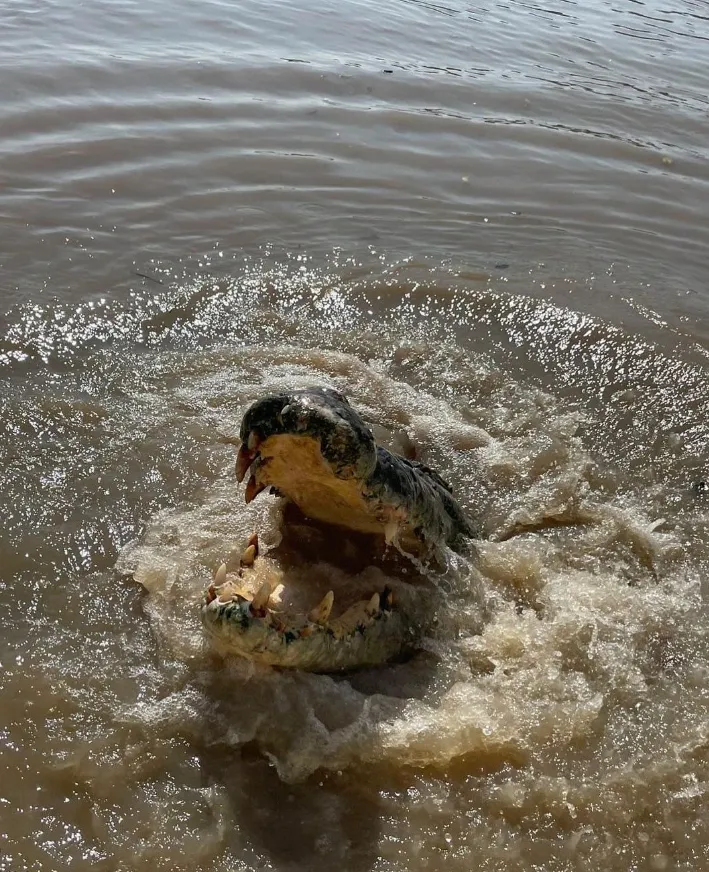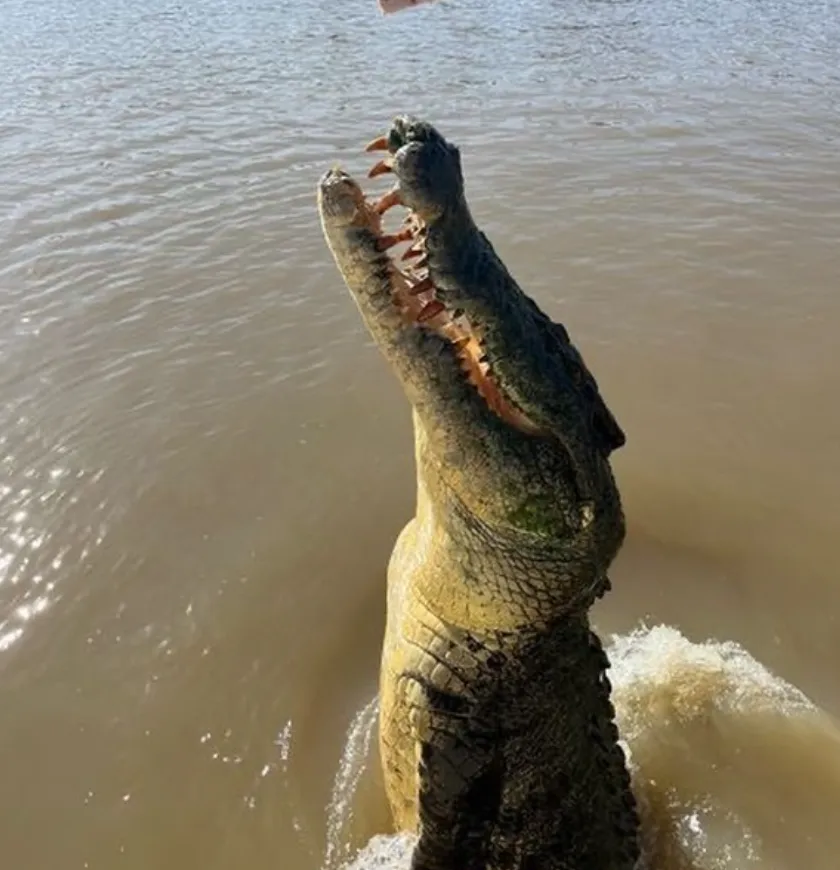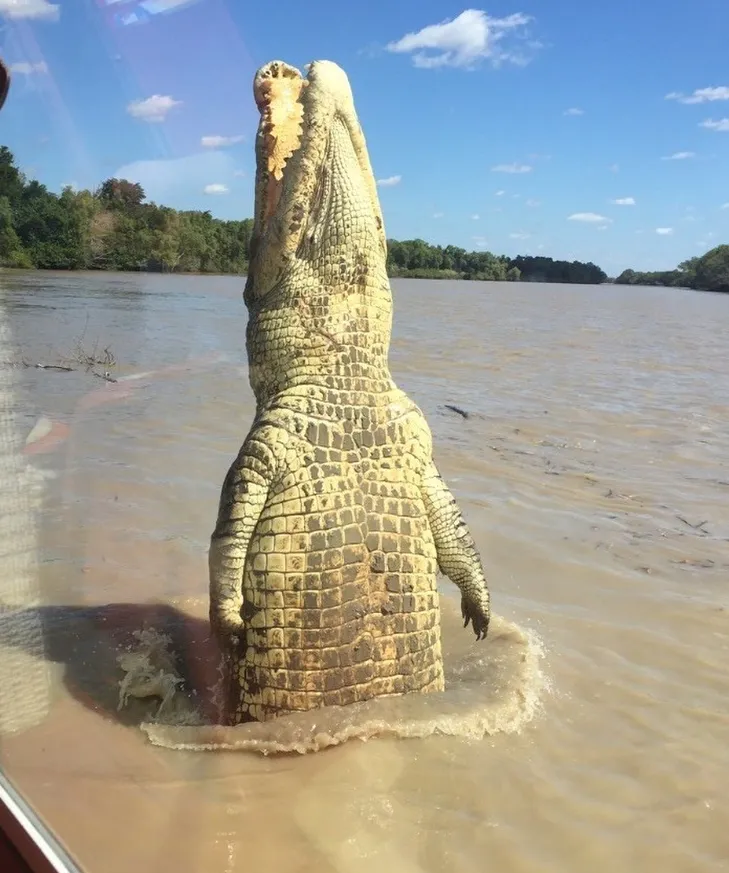What do you think causes a crocodile to jump out of the water? It is thought by many that it is due to their unique anatomy and behaviour, including those of the Saltwater Crocodile, which is known for its ability to leap high into the air.
These fearsome reptiles live mainly in northern Australia’s tropical regions and some parts of Southeast Asia, where they have developed unusual adaptations that enable them to make such huge, powerful jumps. This piece delves deep into these fascinating creatures’ world so as to understand what drives them to jump like no other animal can, looking at their structure and habits as well as where best one can see this incredible feat being performed.
The Anatomy of Jumping Crocodiles
Why Do They Jump?
If we want to know why crocodiles are able to make such amazing leaps, then we must examine their physical features more closely. Among all reptiles on earth today, none surpasses jumping ones in size, with the saltwater species (also called estuarine or Indo-Pacific crocodile) being the largest reptile among them; some individuals grow up to 7 meters long (23 feet) or even beyond. The force behind its ability to come out from water forcefully lies in combination between strong muscles found along its tail and a general body constitution characterized by strength typical of heavy-built creatures.
The tail does not only swim but acts like a springboard, too. Powerful tail muscles serve as an engine for leaping. When readying itself for this activity, an individual may coil back its muscular part which releases energy upon being let go thus launching off surface water into free space above it without any effort. The act is usually done either when hunting food or during courtship displays. Another factor contributing towards better jumping capability is having flexible bodies capable of bending quickly during the propulsion phase, thereby increasing thrust produced.
Moreover, apart from tails, they possessed mouths armed with 64-68 sharp cone-shaped teeth designed primarily for grasping and cutting through the flesh of prey. Crocodiles’ jaws deliver more leverage and power required for jumping higher distances, thus enabling them to do so effectively.
Comparison With Other Crocs Species

Different species exhibit varying degrees of ability when it comes to leaping out of water. For instance, fresh-water crocodile is known to be a very good predator but does not have as much dramatic jumping behavior like saltwater crocodile. This dissimilarity can be attributed to size variation, habitat difference and feeding mode adopted by these two types of reptile.
Saltwater crocodile commonly referred to locally as “saltie” mainly inhabits wide rivers plus estuaries within tropical north Queensland, Northern Territory (Australia)and parts of South-East Asia. Its lifestyle involves aggressive predation, where it jumps up from the surface in order to catch larger prey or protect its territory against intruders. Conversely, fresh-water crocodiles are smaller-sized animals that rely more on their ability to hide beneath water for long periods, waiting for an unsuspecting victim rather than making high jumps towards the potential meal.
Size also matters greatly here since bigger animals possess stronger muscles and hence can propel themselves further than smaller ones during such activities. Therefore, large individuals exert greater force upon takeoff, which makes landing harder, thereby resulting in the earth-shaking event.
Behavioural Insights
Feeding Strategies That Involve Jumping
Jumping has more than just showing off strength for crocodiles since it forms a major part of the feeding strategy used by these reptiles. Saltwater crocodiles use their jumping ability to surprise attack and capture prey items that come too close to the water edge by leaping out of water suddenly and then grabbing hold of anything eatable ranging from small fish, birds like ducks, geese, etc., even large mammals including humans, sometimes.
The leap allows the croc to close the gap between itself and its prey rapidly. This sudden burst of speed power can catch unawares, making it easier for them to secure meals in this way. Then they tear apart whatever has been caught using strong jaws with sharp teeth those creatures possess so well.
It is worth noting that this kind behavior represents another means through which dominance hierarchies become established among members belonging same sex within population under consideration or study . In particular during mating seasons when males compete over access females for reproductive success; doing so ensures that only fittest individuals get chance breed thereby improving overall quality offspring produced each year.

Best Places To Experience Jumping Crocodiles
Famous Locations in Australia
Australia has some fantastic opportunities to see crocodiles leap, with the best known being Adelaide River in Northern Territory where Saltwater Crocs perform amazing jumps for visitors.
The Adelaide River boasts a large population of Saltwater Crocs and there are many tours that run boat cruises providing close up views of these incredible reptiles in action. These croc jumping tours aim at giving people safe but informative experiences showing off the crocodile’s leaping ability among other fascinating behaviors displayed during such occasions.
Another popular spot is Kakadu National Park also located within Northern Territory, a UNESCO World Heritage site offering various wildlife encounters, including viewing different species of saltie (saltwater) crocodiles found here due to its vast wetlands combined with river systems ideal for housing these creatures, thus affording visitors guided walks, 4WD safaris or even airboat rides along flood plains where they can come face-to-face with one of nature’s most ancient predators – if not careful enough!

Wildlife Tours & Safaris
For those who want more than just a quick glance, there are plenty of wildlife tours and safaris which concentrate on crocodile viewing with some including jumping crocs as part of an overall exploration into Australia’s unique fauna.
Crocodile Adventures: These trips offer participants comprehensive insights about different aspects of crocodilian behavior such as the leaping ability. In this case one can learn much about the structure as well as ecology of these reptiles while watching them behave naturally in their environment.
Boat Tours: There are boat cruises that operate through various parts including Adelaide River where visitors get to see saltwater or even freshwater species up close via guides who sometimes use bait during feeding times thus luring them closer to surface allowing for better observation especially when they jump out water towards targets held above it like food dangling from poles.
Conservation and Protection
Danger to leaping crocodile populations
Despite having a fearsome reputation and some impressive adaptations, there are still many significant threats to the population of jumping crocodile. This is because both environmental and human-induced factors contribute to the challenges faced by these top predators.
Environmental Threats: The most important among them is habitat destruction, which is one of the environmental threats to crocodiles. Urbanization, agriculture, and deforestation have caused natural habitats like mangroves, riverbanks, and wetlands to disappear. For a crocodile these areas act like home providing both sheltering space and hunting grounds. Hence, without enough room or the right environment, they become stressed with life, which leads to their limited growth.
Human-Induced Threats: People have greatly affected the numbers of this reptile in various ways; poaching is one such way where it illegally hunted for its skin, which is highly priced in making luxury items, including bags, shoes, etc. Another thing about human beings is that sometimes animals come into contact with humans when looking for food or territory, hence causing conflicts between the two sides and therefore either get killed on the spot or relocated, thereby disrupting their natural behaviour together with social structures.

Efforts Directed at Safeguarding
However difficult it may appear but at least there exist diverse conservation programs aimed at protecting this unique group of reptiles from extinction. These initiatives remain essential since they enable survival of such remarkable living things plus maintenance equilibrium within ecosystems where they inhabit.
Conservation Programs: Different organizations like Queensland Parks & Wildlife Service (QPWS), as well as the Northern Territory Government (NTG), run some of these projects, which mainly involve monitoring numbers, among other things.… Through tracking them down, studying their behaviours so that measures can be put in place to deal with crocs-human conflicts. Conservationists also educate local communities on safety precautions regarding living near wild animals, besides creating awareness about the importance of conserving natural habitats.
Preservation Initiatives: Preservation initiatives are centered around restoring key areas for croc’s survival such as wetlands and river systems. This is done by working closely with landowners/stakeholders towards implementing conservation practices while taking into account impacts related to human activities.… Some zones have been demarcated as protected where they should breed without interference being allowed whatsoever.
Breeding Programs: There are regions where people have established breeding programs aimed at increasing the numbers of these reptiles. What happens here is that eggs collected from the wild are taken into the controlled environment for incubation purposes, after which hatchlings get released back to their original habitats.… With this strategy, more young ones will stand higher chances of surviving, thereby contributing greatly towards healthier croc populations
Cultural Significance Of Jumping Crocodiles
Among Australian Indigenous People
Jumping crocodiles hold great cultural significance within Aboriginal societies of Australia. For many aboriginal communities, these creatures are regarded as ancient beings, and spiritual connections exist between them and individuals.… They feature prominently in Dreamtime stories, which depict events believed to have taken place during creation times when Earth was still young, together with all other things upon it, including humans.
Significance And Stories: Traditional art forms often represent various kinds of animals, including Leaping Crocodiles, but mostly through decorative patterns or symbols engraved/painted onto different surfaces like bark paintings, etcetera… Such stories could touch on issues dealing with power struggles between natural forces, the balance of nature, etcetera… In some instances, such tales may reveal that there were certain areas inhabited only by particular clans due to the presence of waters inhabited by these reptiles, hence indicating respect shown towards them by aboriginals.
Cultural Practices: Apart from their religious meaning, crocodiles are also involved in cultural activities. For instance, some Aboriginal groups use teeth and skins of crocodiles during ceremonies and rites. These customs underscore the deep relationship between native Australians and nature which mirrors the value attached to them by different people.

In Popular Media
Jumping crocodiles have always been a great attraction for people around the world; they have therefore found their way into popular media and entertainment. Films on these amazing reptiles usually show the dramatic leaps made by them as well as their formidable hunting skills.
Representation in Films: Films such as “Jurassic Park” that feature jumping crocodiles have contributed towards creating myths around this creature. Such portrayals though fictionalized, serve to sensitize people about its behaviour and conservation concerns. Many times media presentations concentrate on fun and danger associated with crocs which appeals to adventure loving audience’s curiosity.
Documentaries and Educational Programs: Numerous documentaries have been produced over time showing how jumping crocs behave under different conditions. Shows like “Crocodile Dundee” among others bring out unique characteristics exhibited by these animals while in their natural habitat thus underscoring their role within ecosystems. Through such movies, they help educate the masses about them, thereby fostering efforts geared towards conserving these species.
How to Stay Safe Around Jumping Crocodiles
Safety Tips for Tourists and Locals
If you plan to visit places where there are jumping crocs, it is important that you follow safety measures so as not find yourself in dangerous situations. It should always be remembered that these creatures are powerful but unpredictable hence everyone including travelers needs to take precautions.

Guidelines for Avoiding Attacks
Avoid Swimming in Crocodile Habitats: People should keep off waters known for being infested with crocs even if signposts indicate so because sometimes signs might be missing or damaged.
Stay on Designated Paths: In parks or reserves having areas set aside for these reptiles; use marked trails and boardwalks while moving around such regions since they can easily hide near water edges.
Supervise Children: Kids must be watched closely when playing near ponds, lakes or riversides where jumping crocodiles live. Teach them about dangers associated with being close to water bodies inhabited by these animals and emphasize on the need of staying away from them.
Boat Tour Safety: When going for boat trips where one expects to see crocodile shows ensure that instructions provided by guides are followed strictly. Such Darwin Jumping Crocodile tour are meant to give people chance watch them within safe distances thus creating lifetime memories. Always listen attentively to what guides say then act accordingly without fear or favor.
What to Do in Case of an Encounter
In case you come face to face with Croc, which is unexpected, knowing how to react may save your life.
Conclusion
Crocodiles that jump high out of water have always been fascinating creatures due to their ability, which never ceases to amaze people even after millions of years since they evolved into existence here on Earth.
These reptiles not only captivate the imagination because they leap but also show complex nature from different angles, like cultural significance attached to them or even through other aspects such as leaping heights exhibited during hunting sessions. Therefore, we should keep exploring this area while keeping in mind the necessary protection measures so that they are not wiped away from our planet forever.
Frequently Asked Questions
What enables crocodiles to jump so high?
Saltwater Crocodiles can jump really high because their bodies are built for it. These reptiles have very strong tails and powerful leg muscles, which allow them to push off the ground with great force.
What are some threats facing crocodile populations worldwide?
Some threats facing these reptiles include habitat loss due to human activities like construction or deforestation.
Where in Australia can I see jumping crocodiles?
You can see jumping crocs along the Adelaide River, which is about an hour’s drive from Darwin city centre. Another popular spot is Kakadu National Park where you take boat tours on Yellow Waters Billabong or East Alligator River for close up views of large numbers basking in sun around riverbanks etcetera.
How do I stay safe around crocodiles?
To avoid being attacked by a hungry croc, always swim only in designated safe areas; never go near the water’s edge during darkness (dusk/dawn); don’t walk through shallow, muddy waters.
What do I do when confronted with an angry saltie?
Saltwater crocodiles, being one of the most aggressive types, should not be provoked but rather left alone whenever possible; however, if approached, DO NOT RUN because these reptiles can outrun humans over short distances; instead, back away slowly while keeping eye contact with animals.
